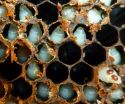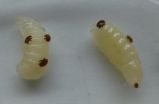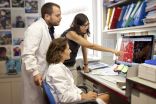What bee-killing mites can teach us about parasite evolution
2015-07-02
(Press-News.org) An infestation of speck-sized Varroa destructor mites can wipe out an entire colony of honey bees in 2-3 years if left untreated. Pesticides help beekeepers rid their hives of these parasitic arthropods, which feed on the blood-like liquid inside of their hosts and lay their eggs on larvae, but mite populations become resistant to the chemicals over time.
While exploring plant-based alternatives to control Varroa mites, Chinese bioagricultural and Japanese cell physiological labs saw that certain tick repellents repress mites from finding their honey bee hosts. In a paper published on July 2 in Cell Reports, they describe how the repellents activate a sensory protein (the transient receptor potential or TRP channel) found on the mites' front legs. That a single protein could influence something so important for mite survival is evidence that the protein may have helped the mites adapt as honey bee parasites in the hive environment.
"Several plant-derived tick repellents activated the TRPA1 channel in Varroa mites but had no effect on the TRPA channels in honey bees and fruit flies," said senior study author Tatsuhiko Kadowaki, an associate professor of biology at Xi'an Jiaotong-Liverpool University. "This is a good example of TRP channel evolutionary plasticity since the mite version was capable of acquiring new activation mechanisms during evolution."
TRP channels have a known role in sensation across many living things. The proteins, found along the surface of various cell types, are used to detect whether the environment is hot or cold for some organisms, while for others they are important in vision, hearing, smell, and taste. When Kadowaki's team activated TRPA1 channel activity in Varroa mites, it could repress them from entering honeycombs with bee larvae, where they reproduce.
"The Varroa TRPA1 channel is the first TRP channel characterized in Acari, which includes mites and ticks, representing the majority of external parasites of various animals and plants," Kadowaki said. "We'd like to further understand the roles of TRP channels in host-parasite interactions and the underlying molecular and cellular mechanisms of the adaptations necessary for successful parasitism."
In addition, his lab would like to explore whether natural pesticides could be developed that specifically target TRP channels.
INFORMATION:
This work was supported by the Suzhou Science and Technology Development Planning Programme (Grant#: SYN201213).
Cell Reports, Peng and Kashio et al.: "Plant-derived tick repellents activate the honey bee ectoparasitic mite TRPA1" http://dx.doi.org/10.1016/j.celrep.2015.06.025
Cell Reports, published by Cell Press, is a weekly open-access journal that publishes high-quality papers across the entire life sciences spectrum. The journal features reports, articles, and resources that provide new biological insights, are thought-provoking, and/or are examples of cutting-edge research. For more information, please visit http://www.cell.com/cell-reports. To receive media alerts for Cell Reports or other Cell Press journals, contact press@cell.com.
[Attachments] See images for this press release:


ELSE PRESS RELEASES FROM THIS DATE:
2015-07-02
To observe the brain in action, scientists and physicians use imaging techniques, among which functional magnetic resonance imaging (fMRI) is the best known. These techniques are not based on direct observations of electric impulses from activated neurons, but on one of their consequences. Indeed, this stimulation triggers physiological modifications in the activated cerebral region, changes that become visible by imaging. Until now, it was believed that these differences were only due to modifications of the blood influx towards the cells. By using intrinsic optical signals ...
2015-07-02
Healthy people given the serotonin-enhancing antidepressant citalopram were willing to pay almost twice as much to prevent harm to themselves or others than those given placebo drugs in a moral decision-making experiment at UCL. In contrast, the dopamine-boosting Parkinson's drug levodopa made healthy people more selfish, eliminating an altruistic tendency to prefer harming themselves over others. The study was a double-blind randomised controlled trial and the results are published in Current Biology.
The research provides insight into the neural basis of clinical disorders ...
2015-07-02
BETHESDA, MD - The American Society of Human Genetics (ASHG) Workgroup on Pediatric Genetic and Genomic Testing has issued a position statement on Points to Consider: Ethical, Legal, and Psychosocial Implications of Genetic Testing in Children and Adolescents. Published today in The American Journal of Human Genetics, the statement aims to guide approaches to genetic testing for children in the research and clinical contexts. It also serves as an update to the Society's 1995 statement of the same title, which was issued jointly with the American College of Medical Genetics.
"Twenty ...
2015-07-02
Idiopathic pulmonary fibrosis (IPF) causes a gradual loss of respiratory capacity and can be lethal within a few years. The cause is unknown, although it can be attributed to a combination of genetics and the environment. A team of researchers from the Spanish National Cancer Research Centre (CNIO) have now discovered that telomeres, the structures that protect the chromosomes, are at the origin of pulmonary fibrosis. This is the first time that telomere damage has been identified as a cause of the disease. This finding opens up new avenues for the development of therapies ...
2015-07-02
A mutation found in most melanomas rewires cancer cells' metabolism, making them dependent on a ketogenesis enzyme, researchers at Winship Cancer Institute of Emory University have discovered.
The finding points to possible strategies for countering resistance to existing drugs that target the B-raf V600E mutation, or potential alternatives to those drugs. It may also explain why the V600E mutation in particular is so common in melanomas.
The results are scheduled for publication in Molecular Cell.
The growth-promoting V600E mutation in the gene B-raf is present in ...
2015-07-02
The first comprehensive analysis of the woolly mammoth genome reveals extensive genetic changes that allowed mammoths to adapt to life in the arctic. Mammoth genes that differed from their counterparts in elephants played roles in skin and hair development, fat metabolism, insulin signaling and numerous other traits. Genes linked to physical traits such as skull shape, small ears and short tails were also identified. As a test of function, a mammoth gene involved in temperature sensation was resurrected in the laboratory and its protein product characterized.
The study, ...
2015-07-02
MAYWOOD, Ill. - New devices called stent retrievers are enabling physicians to benefit selected patients who suffer strokes caused by blood clots. The devices effectively stop strokes in their tracks.
For the first time, new guidelines from the American Heart Association/American Stroke Association recommend the treatment for carefully selected patients who are undergoing acute ischemic strokes and who meet certain other conditions.
Loyola University Medical Center stroke specialist Jose Biller, MD, is a member of the expert panel that wrote the guidelines, published ...
2015-07-02
Infrared date from NASA's Aqua satellite spotted the strongest storms within newborn Tropical Depression 10W over the Philippine Sea today, July 2. It is expected to strength to a tropical storm, at which time it will be renamed "Linfa."
A tropical cyclone is made up of hundreds of thunderstorms, and the highest storms are the coldest and most powerful. To identify those areas with the strongest storms, infrared data is used because it tells temperature. The higher the cloud top, the stronger the uplift in a storm and the colder the cloud top temperature will be.
The ...
2015-07-02
By growing two types of stem cells in a "3-D culture" and measuring their ability to produce retinal cells, a team lead by St. Jude Children's Research Hospital researchers has found one cell type to be better at producing retinal cells.
The research not only reveals which stem cell type might be better for treating retinal degeneration, but it also demonstrates a standardized method for quantifying the effectiveness of different stem cells for such therapies.
The research was led by Michael Dyer, Ph.D., a member of the St. Jude Department of Developmental Neurobiology ...
2015-07-02
Astronauts on the International Space Station (ISS) have a number of exercise options, including a mechanical bicycle bolted to the floor, a weightlifting machine strapped to the wall, and a strap-down treadmill. They spend a significant portion of each day working out to ward off the long-term effects of weightlessness, but many still suffer bone loss, muscle atrophy, and issues with balance and their cardiovascular systems.
To counteract such debilitating effects, research groups around the world are investigating artificial gravity -- the notion that astronauts, ...
LAST 30 PRESS RELEASES:
[Press-News.org] What bee-killing mites can teach us about parasite evolution




